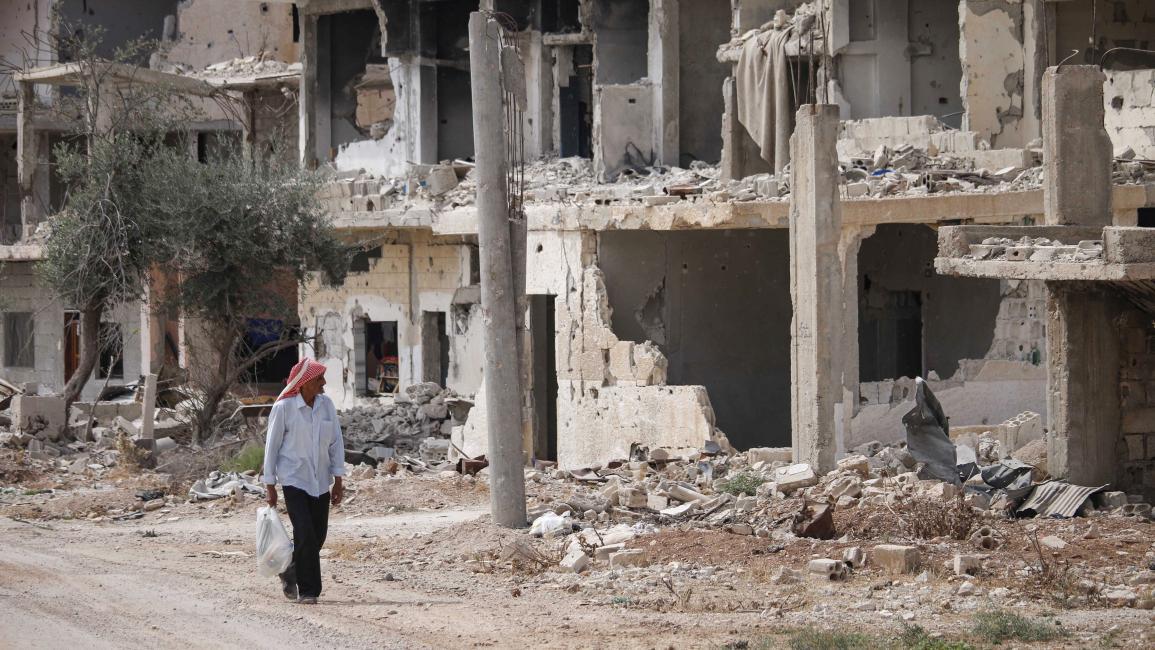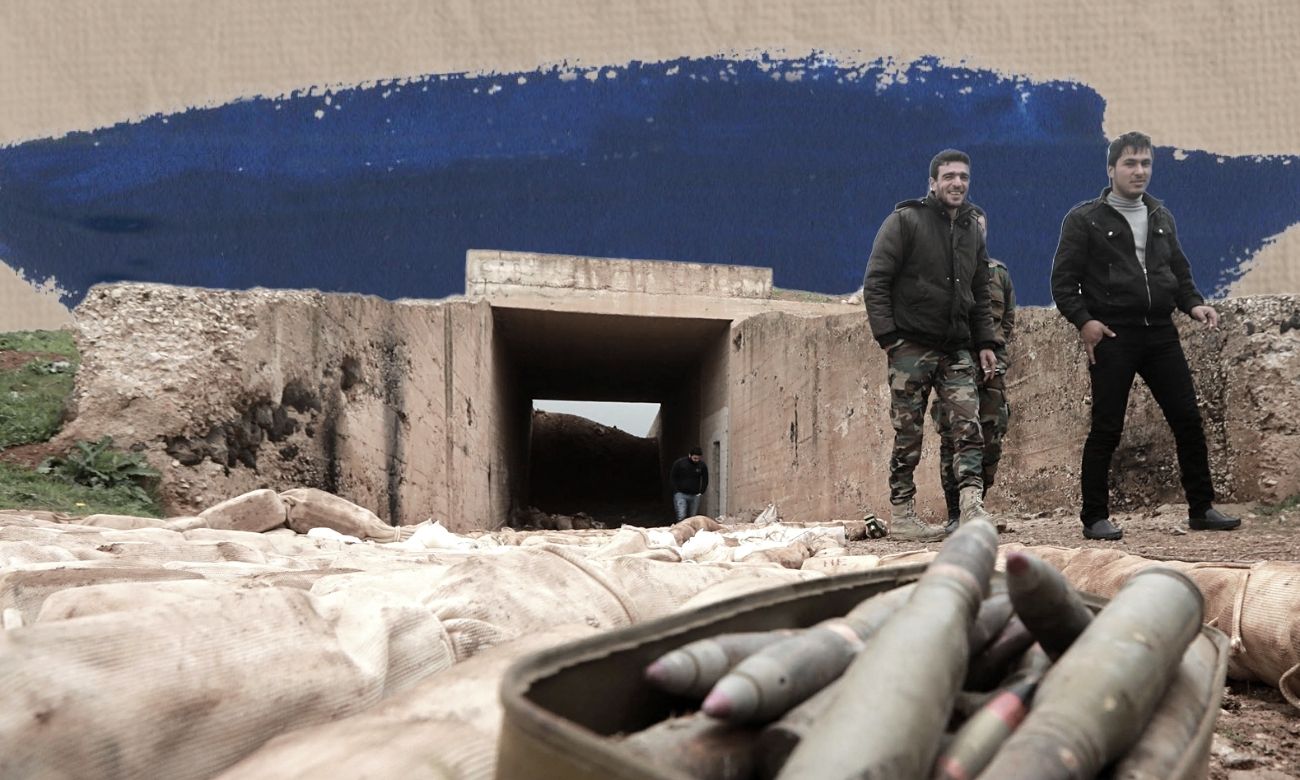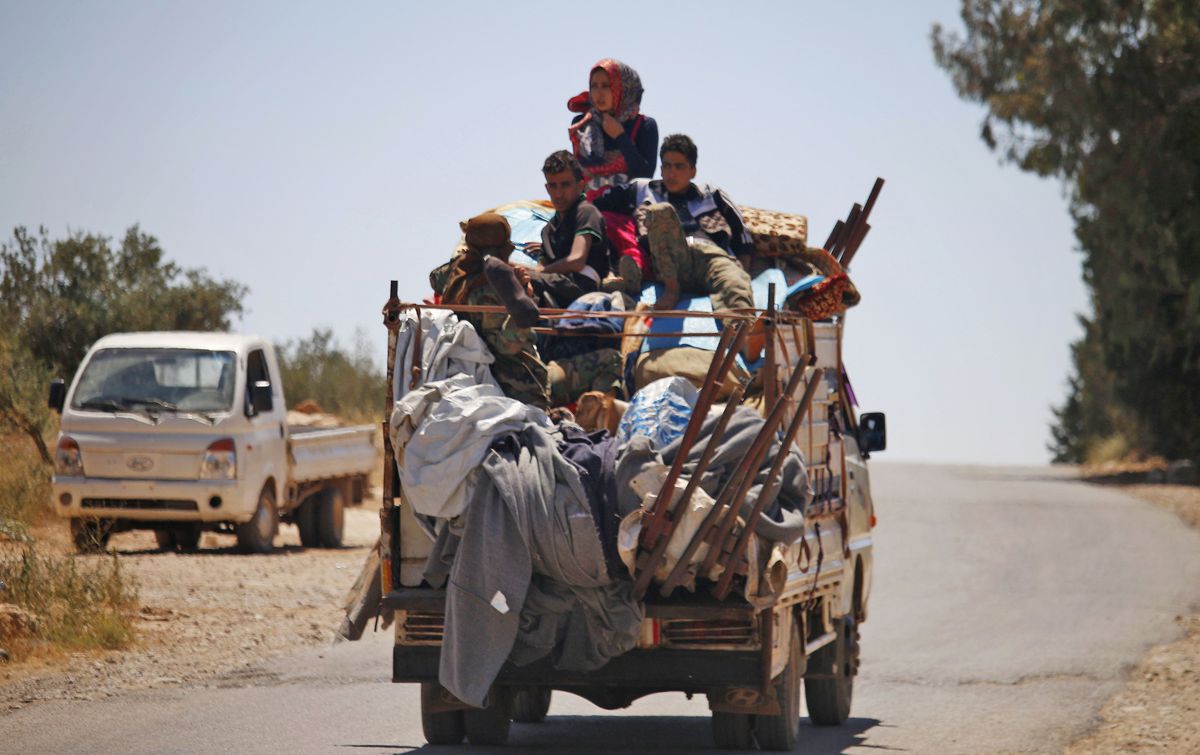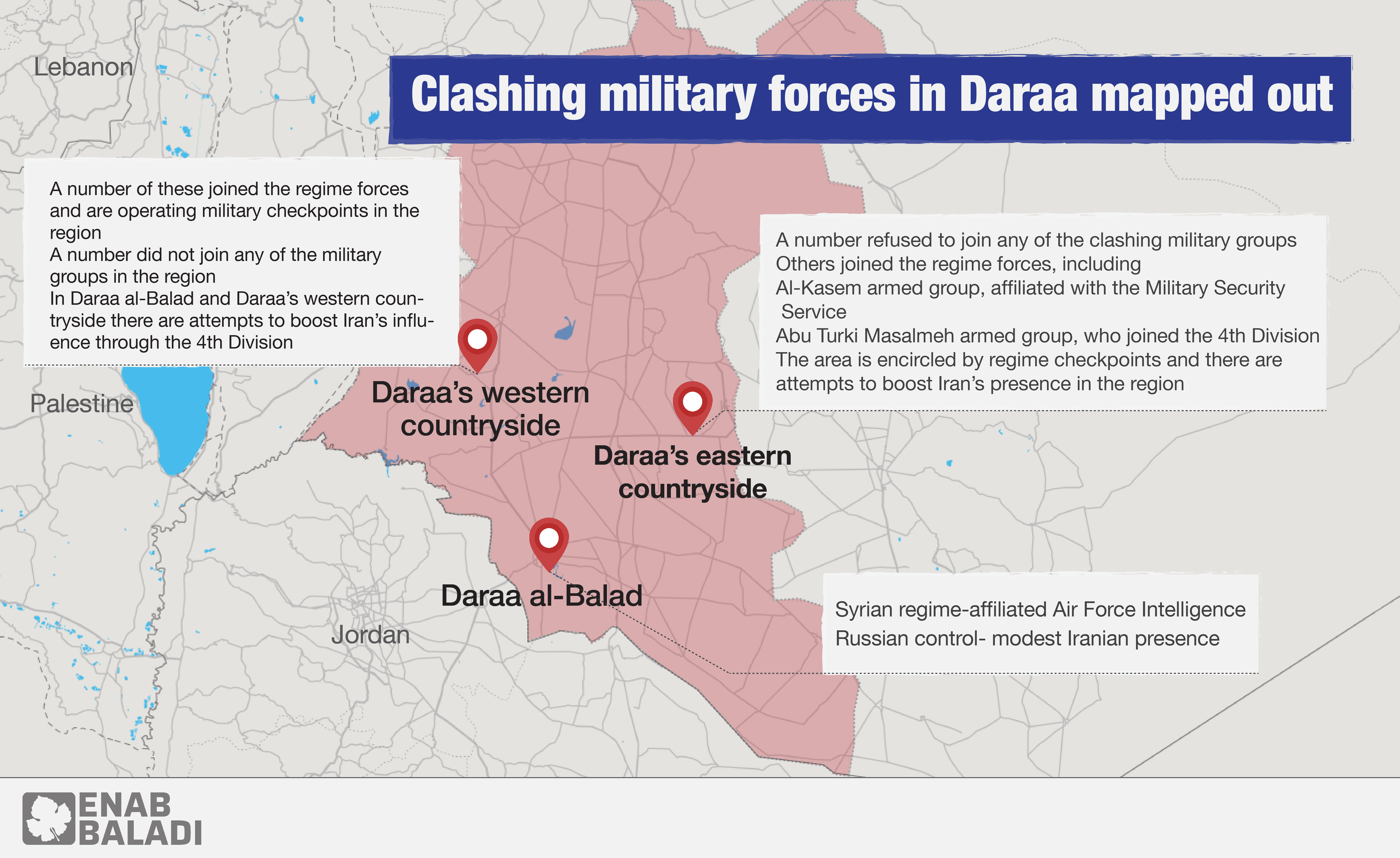Zainab Masri |Khaled Jeraatli |Hussam al-Mahmoud
The Syrian regime forces indeed managed to reestablish control over Daraa city in August 2018, imposing a “settlement” agreement of 11 provisions on the locals who wished to remain in their homes. However, the forces’ military hegemony did not bring about meaningful stability and the city continued to be a massive security gap in the regime forces’ territories.
Instability within the province— where the regime, Russia, Iran and the Islamic State (IS) share control—manifested in rampant insecurity and hiking numbers of assassinations, the perpetrators of which mostly remain unknown.
The recent upheavals in Daraa that followed the government’s latest revolt against the regime, as locals refused to participate in May’s presidential elections, proved once again the fragility of the agreements the regime is signing in presumably “settled” areas.
In response to the popular disobedience, the regime hastened to instigate its ally Russia against the city and mobilized its forces to cordon and suffocate the population. Additionally, the regime pressed locals again into succumbing to its conditions as a demonstration of loyalty, or else they will be forcibly deported. Nevertheless, the locals held to their refusal, causing the security situation to spiral from instability to direct military confrontations, accompanied by extensive shelling on civilian neighborhoods.
On the ground, Russian forces alienated themselves from the battle, leaving more room for the regime’s other key ally, Iran, to fight against former armed opposition fighters, who signed a settlement agreement and then either joined Russian military formations or returned to their civilian lives (hereinafter local fighters).
At the negotiating table, the regime and local committees continue to hold talks.
Amidst the escalating violence, successive military developments and political decisions, the population continues to suffer the woes of the war machine, backed by barely audible international condemnation.
In this in-depth article, Enab Baladi investigates the reasons that caused the Syrian regime’s restrictive security policies to fail and political “settlements”— used to recapture lost areas— to collapse. Furthermore, Enab Baladi discusses with political analysts the future of southern Syria as the regime insists on military escalation as a solution to curb the population’s newest revolt.
Rapid changes in Daraa
A group of young men surrounded Hamza, 35, who still held his rifle and wore his bandoleer over his shoulder. Taking a moment to rest after he took over a security checkpoint, he recounted to Enab Baladi the details of the first day they started targeting regime forces’ checkpoints and posts in the western countryside of Daraa.
“We attacked, encircled the checkpoint, and asked the personnel to surrender. We do not intend to shed blood, we just want to send the regime a message to press it into stopping the military campaign” said Hamza, a former armed opposition fighter from Daraa.
He added that the checkpoint soldiers were clearly afraid. They surrendered immediately and were relocated to secure places, protected from the regime’s shelling. As for their weapons, we collected the arms we found and put them in the possession of certain bodies chosen by the area’s residents.
Fighter Hamza stressed that the groups of fighters who participated in the attack on the checkpoints were “highly professional” as they carried out the tasks assigned to them. “This indicates that the regime’s control over the city in 2018 eliminated the factional rifts among fighters and that what brings these fighters together today is the duty to save Daraa and every area the regime attempts to besiege and invade.”
“I felt a sense of victory when we brought down the regime’s flag that personnel displayed at the checkpoint. This deepened my faith that the revolution did not and will not die and that we are capable of pushing the regime back to pre-2018 [borders] whenever we wished.”

Syrian man passing near the rubble of buildings in a neighborhood controlled by the Syrian armed opposition in Daraa city, south of Syria — 2 October 2018 (AFP/Muhammad Abazaid)
Military operations that changed the game
On the morning of 29 July, Syrian regime forces, backed by Shiite and local militias, began storming the neighborhoods of Daraa al-Balad. Within hours, local fighters started attacking regime-affiliated checkpoints in the eastern and western countryside of Daraa and the Jaidour area, north of Daraa governorate, using light weapons.
Soon, news and pictures flooded the internet capturing the fall of regime checkpoints.
Personnel at these checkpoints did not resist. Most of the soldiers surrendered themselves with their weapons while local fighters imprisoned dozens of officers and non-commissioned officers deployed to these checkpoints.
One of the local fighters that attacked the checkpoints in the western countryside of Daraa, who is a former opposition commander, told Enab Baladi that the fighters had target checkpoints defined and tasks assigned to groups earlier. Everyone was waiting for the zero hour to relieve the pressure on Daraa al-Balad.
Just as regime forces began storming Daraa al-Balad, each group of fighters set out to the target location they are assigned to attack. With “swift and coordinated” operations, the fighters had most of the checkpoints in Daraa’s western countryside under their control.
The seized checkpoints were guarded by officers and non-commissioned officers from the “Syrian Army,” sent there by the regime-affiliated 4th Division, who also backed them with reconciled former opposition fighters (hereinafter reconciled fighters).
The local fighters relied on the reconciled fighters’ disloyalty to the regime, which helped them achieve a quick control over the Zayzun Military camp—the headquarters of the 4th Division— the Asa’iqa Military Camp, and the al-Aghrar Training Center, in addition to dozens of checkpoints and military points.
As local fighters attacked checkpoints in Daraa’s western countryside, other groups of fighters were on the move in Daraa’s eastern countryside. They targeted and removed checkpoints that were mostly operated by the Air Force Intelligence Service, covering areas extending from the Busra village, adjacent to As-Suwayda governorate, to the al-Naimeh town, adjacent to the eastern side of Daraa governorate’s center.
The fighters seized a tank and anti-aircraft guns and captured dozens of regime fighters in the eastern countryside of Daraa.
On the condition of his anonymity, a member of the Daraa Central Committee (DCC) told Enab Baladi that these attacks were a “subtle” message that Hauran is one body with one fate, to the extent that fighters from Russian-backed 8th Brigade participated in the attacks.
The DCC member pointed out that Russia is against Iran’s growing influence in Daraa, because Iran has been ramping up its presence at the expense of Russian forces, and that stopping the expansion of Iranian militias is one of Russia’s chief promises to the international community and Israel.
He added that Russia asked local fighters to hand over the prisoners as a gesture of goodwill that would pave the path for serious negotiations to end the military campaign on Daraa al-Balad without igniting a war.
He added that the recent attacks by local fighters have even changed the course of the negotiations that the regime-affiliated Security Committee (SC) is no longer talking to Daraa al-Balad’s committee alone, but it is rather addressing the Hauran Committees representing the region’s western and eastern parts.
How did the siege start?
Retaliating against Daraa’s position of the presidential election, the regime incited Russia against the governorate. This was obvious in the demands Russia laid down for the opposition. The Russian General, nicknamed Assaduallah and who is in charge of the Daraa Russian Military Police, ordered former armed opposition fighters to surrender their light weapons.
Assadullah ordered the DCC in Daraa al-Balad to hand Russian forces 200 individual arms and 20 BKCs, in addition to allowing Russian forces access into the city to carry out inspections, promising to disband the regime-affiliated militias operating in the city in return. The DCC refused these demands, however.
The DCC denied that the city’s residents possessed any weapons, noting that the opposition factions handed over their weapons in July 2018, after the regime took control of Daraa and Quneitra governorates under the “settlement” agreement.
Consequently, regime forces laid siege to the city, prevented the delivery of humanitarian aid, tightened security measures against the locals, and escalated their military activities there.
Western countries condemned this escalation and called for an immediate ceasefire in the region, but the regime decried this condemnation and considered it an “incitement and hypocrisy,” stressing that it will not stop the campaign launched “to restore security and stability across the country.”
Violated agreements
The regime violated the first agreement it signed with the locals following the siege and accused the DCC of breaching the deal, which the DCC denied.
The first agreement provided for the deployment of regime-affiliated 9th Division checkpoints within Daraa al-Balad. The DCC approved, but 4th Division fighters tried to storm the city as the 9th Division started spreading checkpoints.
While regime forces tried to enter the city, local fighters in the eastern and western countryside of Daraa resisted, attacking the regime’s military checkpoints and security headquarters in the area. These attacks cost the regime over 60% of its military posts in the area, which prompted it to reconsider negotiations.
On 29 July, the regime called for a new round of negotiations, in an attempt to gain time to fathom the attacks in Daraa’s countryside because local fighters captured over 200 prisoners from regime forces, who were subsequently released in a prisoners swap.
With the start of the new negotiations, the regime’s SC held to its demands, including the deportation of fighters from the city to northern Syria, handing over weapons in the city, and deploying security checkpoints, which the representatives of Daraa al-Balad rejected, especially following the deaths and injuries the regime’s escalation caused among the city’s residents.
As the negotiations failed, the battles sparked again and all the regime’s attempts to storm the city failed, combated by the steadfastness of the people of the region and their desperate defense of the city.
Simultaneously, local fighters continued to carry out attacks in separate areas of Daraa’s countryside, targeting the regime’s checkpoints to relieve the pressure on Daraa Al-Balad.
As regime forces failed to storm the city several times in a row, the Minister of Defense in the regime’s government, General Ali Ayoub, arrived on 2 August at the Baath Party building in the al-Mattar neighborhood, in the Daraa al-Mahatta, adjacent to the besieged Daraa al-Balad. Ayoub intended to meet with the regime’s SC. Later, people learned that a new round of negotiations was underway in the city, mediated by Russia. A Russian delegation, headed by officer Assadullah, was holding a meeting with the defense minister and a number of the SC officers in the al-Mattar neighborhood in Daraa city.
This round of negotiations failed too and the confrontations started again with the regime’s attempts to break into Daraa al-Balad, where civilians suffered in the throes of deteriorating humanitarian conditions.
On 3 August, the local Nabaa News Agency quoted an informed source as saying that a new 24-hour ceasefire will be enforced in Daraa with the revived negotiations between the negotiations committee, regime officers, and Russia regarding the cordoned city.
The unnamed source added that the negotiations committee made a new proposal, providing for spreading regime forces (of the military security and the 15th Division), in addition to fighters from the Russia-backed 5th Corps in several locations in Daraa al-Balad and other neighborhoods. However, the source did not reveal any information as to the results of this round of negotiations.
This last ceasefire also failed. The regime forces once again extensively shelled the city and Iran-affiliated 4th Division fighters attempted to storm its neighborhoods from different fronts.
Even though the former commander of the Free Syrian Army, Muhammad al-Masalma, nicknamed al-Hafu, announced leaving Daraa al-Balad, along with Muayyad Harfush, answering the regime’s demand that opposition fighters be deported from the area in exchange for stopping the military campaign in the area, regime forces continued their hostilities against the locals.
The Daraa Martyrs Documentation Office reported that the regime bombarded cities and villages in the governorate using highly explosive ground-to-ground missiles several times on the same day. The hostilities killed a man, a woman, and three children from the same family in the Yadouda city, west of Daraa.
Additionally, the office documented the death of eight civilians in separate strikes of regime forces on various areas in Daraa, including a woman and four children.
According to recent casualty figures, the office published on 30 July, 12 civilians died over the first days of the military clashes in Daraa.
Is the regime really in control of “settlement” areas?
Regime forces in the cities and villages covered by the “settlement” agreements in Homs and Aleppo went on alert in conjunction with the recent escalation in Daraa governorate. The regime is concerned that these cities too might revolt in solidarity with Daraa al-Balad.
Members of the regime security forces and law enforcement were deployed in the neighborhoods of the city of Aleppo, especially the eastern ones, at the dawn of 30 July. A large number of these forces were stationed near mosques for fear of demonstrations in support of Daraa, or to denounce the deteriorating security and living situation in the area.
The regime forces also ordered mosque Imams in Aleppo to explain the current events in the city of Daraa as a “new conspiracy after the presidential elections,” and that “Syria’s enemies want the return of killing and destruction after stability,” an imam in the Hanano area, in Aleppo told Enab Baladi’s correspondent.
The same tightened security measures were enforced in Homs governorate. The regime instructed security forces to intensify night patrols in the northern countryside of Homs city, which was included in the Russia-mediated “settlement” agreement, for fear of any anti-regime protests in solidarity with Daraa al-Balad.
Researcher and political analyst Nasr al-Youssef told Enab Baladi that the regime’s fear of the “settlement” areas was evident in the manner it dealt with these cities and villages during the presidential elections last May.
He added that the tightened security measures the regime enforced in these areas during the military escalation in Daraa reflect the regime’s conviction that if Daraa manages to completely break out of its control, other cities will follow suit, which will also be liberated, even if partially, from its security grip.
Russia: a mere guarantor or in control?
Southern Syria’s future following recent unrest
The Russian officer Assadullah first asked Daraa’s people to hand over their weapons shortly after they refused to participate in the presidential elections. Later, however, Moscow, its forces and warplanes remained on the sidelines after the situation in Daraa evolved into military clashes.
Nevertheless, Russia reappeared at the forefront following the news on a possible ceasefire in Daraa al-Balad, discussed in the meeting mentioned above between a Russian delegation, the regime’s minister of defense General Ali Ayoub, accompanied by officers from the SC, held in the al-Mattar neighborhood in Daraa. In conjunction with the meeting, a Russian military force entered al-Mattar neighborhood.
Considering that it was a guarantor of the “settlement” between them and the regime in 2018, Daraa city residents called on Russia to respect its obligations related to its role as a guarantor. Additionally, the locals demanded that representatives of the Syrian opposition withdraw from international negotiations with the actors in the Syrian issue until the siege— imposed on the area about two months ago— is lifted.
In a statement issued on 4 August, the locals said that the regime is trying to end this “settlement,” which means a blow to Russia’s efforts as a guarantor of the agreements in Syria.
Moscow’s response to the events in Daraa and the role it plays in the ongoing negotiations raises questions about whether Russia’s role is limited to being a “guarantor” or a “controller” of the situation in southern Syria.
For his part al-Youssef said that Russia is at the same time a guarantor of the agreements and a main controller of the events.
He said that Russia actually can act as it wishes in Syria, not because it has the power to do so, given that neither the regime’s nor Iran’s force could be compared to Russia’s, which as of 2015 helped sustain the regime and reinstate its control over the captured areas.
However, Russia claims that it cannot control the course of events in Daraa because this claim is appropriate for its relationship with the international community. For example, Russia can deny its role as a controller when it is asked to do things against its will, saying that it cannot impose certain conditions on al-Assad or interfere in the internal affairs of Syria.
Researcher al-Youssef posed an essential question, could a country that interfered with the formation of new units in the army of another country, simply not interfere in the internal affairs of that country?
Russia’s refusal to intervene in Syria is a “lie,” al-Youssef said, as it insists on pretending to be democratic by not interfering in the internal affairs of the regime.
In his turn, political researcher Wael Alwan told Enab Baladi that Russia is not trying to discipline the regime and Iran through escalation in southern Syria, adding that Russia had no idea about the extent of attrition that could befall the 4th division.
He added that Russia is interested in disciplining the southern region through pressuring locals and the military threats posed by Iran, its militias and the 4th Division.
He added that Russia is interested in disciplining the southern region through pressuring locals and the military threats posed by Iran, its militias and the 4th Division.
The pressure on the 8th Brigade was one of the gains that Russia obtained from the unrest in Daraa. Generally, the events took a turn in favor of Russia, researcher Alwan said, adding that the great attrition of the 4th Division lies in Russia’s interest, without even having a role in it.
He added that Russia was pushing for a military escalation in the region to effect this shock and these losses within the regime forces.
The analyst discussed the potential scenarios ahead of Daraa, as either calm, or further escalation.
Alwan believes that the situation in Daraa al-Balad is heading towards calm, and the establishment of a new “settlement” in which the 8th Brigade plays a major role, more than any time before.
He pointed out that everything that is happening in Daraa is related to the popular resentment across the southern governorates (Daraa, As-Suwayda, and Quneitra) over Iran and Hezbollah’s presence in the region. The presence of these forces constitutes a source of concern and is pushing for a state of alert among the governorate’s residents, as well as at the regional and international levels.
He stressed that Russia is dissatisfied with the chaos that coincided with the presidential elections in Syria, in addition to the 8th Brigade’s reluctance to fight in the Syrian desert.
Last April, Arab media outlets reported that the 8th Brigade of the Russia-backed 5th Corps refused to join the battles of the Syrian desert against IS cells, where regime forces and allied militias are failing to advance, according to reports by Russian outlets last June.
Alwan said that Russia is seeking to demarcate anew the “settlement” with Daraa, but on its terms, not those of the 8th Brigade. This requires some risks that currently exist in Daraa, which the Russians are trying to exploit for their interests.
During the military escalation launched by the regime against Daraa al-Balad and its siege, the Russians did not express a clear position on what is happening there, at a time when the Russian media admitted that the regime had lost some of its military checkpoints at the hands of the people of Daraa.
At the same time, Russia is also imposing pressure to prevent the circle of clashes from expanding beyond control and in a manner that would create high-security risks within the regime’s areas of control.
On the fate of the region and the possibility of moving towards autonomy, and the transformation of southern Syria into a model that resembles the one in northeastern Syria, Alwan pointed out that autonomy is a demand supported by regional and international parties, and it was openly talked about among the dignitaries of As-Suwayda and Daraa earlier, but the regime is afraid the issue will be formally proposed and also fears that Russia will agree to it.
Alwan said that Russia is likely to approve Daraa’s self-rule because it needs negotiating paths to find a way to break the political boycott and the siege imposed by the allies of the United States (US) on the Syrian regime. In other words, Russia is ready to accept autonomy in return for the political gains it needs from US allies.

The Russian army negotiating a ceasefire with armed opposition groups in Daraa, south of Syria — 14 July 2018 (AFP)
8th Brigade
Anti-regime Russia-backed armed group
The 8th Brigade was formed from the Shabab al-Sunna (Youth of Sunna) faction, led by Ahmed al-Awda. The former armed group managed the city of Busra’s military and service affairs when the opposition still had control over the area between 2013 and 2018.
Al-Awda refused to have headquarters of the al-Muthanna Islamic Movement and al-Nusra Front in the city of Busra in 2015, after they participated in the battles that led to the city’s liberation from regime forces. Al-Awda’s faction thus dominated the city without competition.
Furthermore, al-Awda faction was funded by the US-led Military Operations Center (MOC), which is based in Jordan.
In 2016, a coup took place within the al-Awda faction. al-Awda’s ammunition and heavy weapons depots were controlled, forcing al-Awda to flee Busra. However, with the support of the Southern Front factions, he was able to storm and recapture the city.
In 2017, al-Awda’s faction clashed with the Yarmouk faction, its rival faction in the eastern region. The two factions lost fighters during the exchanged fires that ended with reconciliation.
In July 2018, Ahmed al-Awda handed over the faction’s heavy weapons under the “settlement” agreement with Russia, retaining medium and light weapons. Al-Awda also maintained the faction’s structure which turned from Shabab al-Sunna to today’s 8th Brigade, operating under the Russia-backed 5th Corps.
if you think the article contain wrong information or you have additional details Send Correction
النسخة العربية من المقال
-
Follow us :
Most viewed
- Intentions for popular resistance amid Israeli escalation in southern Syria
- Turkey moves to deploy air defense system in Syria
- Al-Sharaa names new Syrian government
- SDF to withdraw from Aleppo neighborhoods following agreement with Damascus
- Washington's conditions raise questions about its openness and goals in Syria













 Syrian regime forces standing next to fragments of ammo and explosive devises in Daraa city, south of Syria — February 2019 (AFP/Edited by Enab Baladi)
Syrian regime forces standing next to fragments of ammo and explosive devises in Daraa city, south of Syria — February 2019 (AFP/Edited by Enab Baladi)





 A
A
A
A
A
A










 More In-Depth
More In-Depth